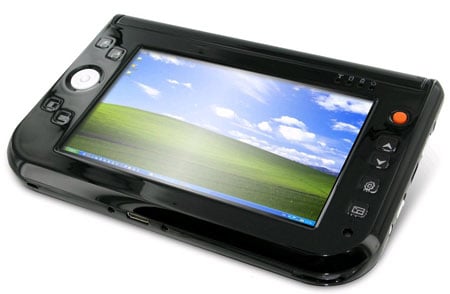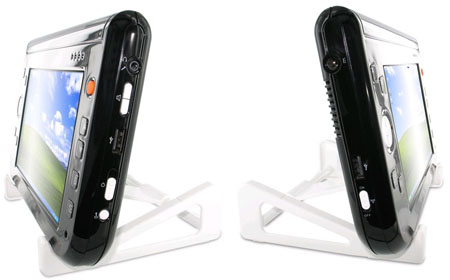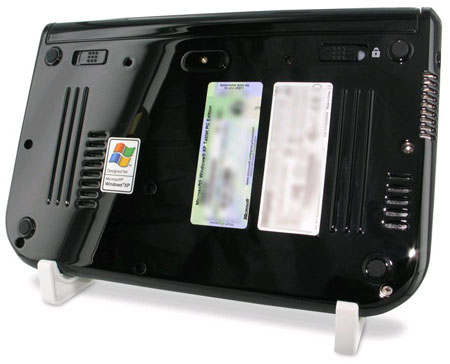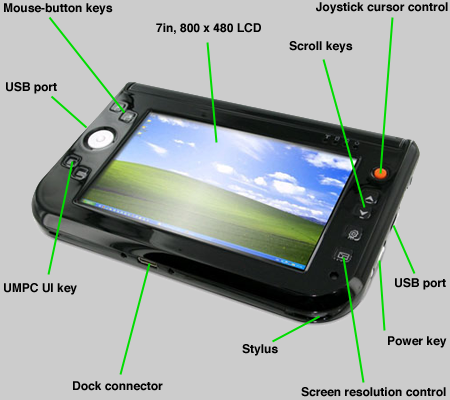Original URL: https://www.theregister.com/2007/03/16/review_ubiquio_701/
Ubiquio 701 ultra-mobile PC
The UMPC finally beats the laptop?
Posted in Personal Tech, 16th March 2007 12:02 GMT
Review It's almost a year since Intel and Microsoft launched the Ultra-mobile PC (UMPC) as a new category of handheld computer. Chip maker VIA touted an early reference design, but its offering was quickly eclipsed by Samsung's Q1 UMPC. But the VIA machines didn't disappear entirely and has now popped up again, this time as the Ubiquio 701.

The 701 is a classically styled UMPC, looking like a half-size Tablet PC or a large personal media player. It's decked out in shiny black plastic, which gives it a slightly cheap feel, but all the key features - a full version of Windows, a laptop-class processor, a hard drive, wireless connectivity - are here.
The 701 starts up for the first time with its 7in screen set to a resolution of 800 x 600. It doesn't look right, since it's clearly not the panel's native resolution. A trip to the display properties panel provides two other choices: 1024 x 600 and 1024 x 768. Again, neither are native resolutions. But there's another way of changing the screen size on a UMPC: the pop-up settings bezel, and its screen sizes options are 1024 x 600, 800 x 600 and 800 x 480. Selecting the latter finally presented me with the screen's native resolution.
When I tried Samsung's UMPC, the Q1, last year, I found its 800 x 480 display severely limited: dialog boxes disappeared off the upper and lower edges of the screen to the extent that you can't see their buttons. You can switch to a larger, non-native resolution and view them complete, but they lack the sharpness of the true screen size.
The 701 beats the Q1 one important respect: its mouse control. The Q1 forces you to use either your finger or the stylus. The 701, however, has a button to the right of the screen that works just like the tiny joysticks you see on some laptop keyboards. It'll steer the cursors all around the screen, and you can tap it to click.
Below the cursor control are a pair of keys for up and down scroll actions, followed by a button to pop up the aforementioned control bezel - with brightness, screen size, main display, volume and mute selectors - and, below that, a button that goes straight to the screen-size selection bezel.

On the other side of the screen are buttons to call up the standard stylus-oriented keyboard, Microsoft's Media Center-like simplified UMPC UI, a five-way navigation key - which, as per the Q1, doesn't control the cursor and is generally little-used - and two buttons clearly marked to show they perform right and left mouse button clicks.
All these controls are well placed for thumb-tapping when you hold the UMPC in both hands. With one thumb pushing the joystick and the other tapping the mouse-button keys, the 701 becomes easy to navigate. The only problem arises when you want to type anything in - a website address, say.
In addition to the stylus-oriented on-screen keyboard, Microsoft provides DialKeys, which arranges the QWERTY layout in two half-semicircles at the bottom left and right of the screen. I like DialKeys, which works fairly well for two-thumb typing. The crucial thing to do is calibrate the screen first - I spent ages complaining to myself about DialKeys' poor responsiveness until I realised where I was tapping wasn't where Windows thought I was tapping. I tried to calibrate the display half a dozen times but never got accurate alignment between pressure point and cursor position, but in the end I got it close enough.
DialKeys didn't feel as responsive on the 701 as I remember it on the Q1. With that device you could tap away and be sure it was reading the key-presses. With the 701, I found entering text more a case of press key, wait to see if it's registered, press key again if not or move on to the next one. This makes text-entry slow on the 701, so if you plan to type on one these things you'll really need an external keyboard.
The 701 has Bluetooth 2.0 on board for wireless devices, and a pair of USB ports - one on either side of the UMPC - for peripherals needing a fixed connection. Below the left-hand side USB port you'll find a Wi-Fi power switch; around the other side the USB port is accompanied by the power control, volume keys and an earphone socket. The power control doubles up as the hold control. The telescopic metal stylus slide into a bay at the bottom of the unit.
The 701 retails through Ubiqiuo's exclusive UK supplier, Expansys, for £560. An extra £70 gets you the 701 and the Standard Accessory Pack, which comprises a portable USB keyboard and a leather case to keep the two devices in. You also get some cable ties and a screen-clean kit, but who cares about those? The Accessory Pack is worth it for the keyboard.

You'll also need an optical drive, of course, since one isn't bundled. Yes, you can share a desktop PC's DVD drive over the WLAN, but that's not a simple solution.
What is included is a self-assembly plastic stand, which works but isn't as handy as the fold-out stand that's built into the Samsung Q1. You can also tuck the 701's stylus into a hole in the back the device to create an ad hoc stand, which is fine as long as you don't need the stylus.
The 701 doesn't have the well-built feel that the Q1 does. It also lacks the Q1's integrated Ethernet port, CompactFlash card slot - or any memory card bay, for that matter - and VGA connector. Still, of the two units, the 701 would win my money. It's cheaper and, more importantly, is a darn slight easier to use than the Samsung thanks to the superior control layout and that oh-so-useful joystick control. Of course, Sony's Vaio UX1 has all these too, looks way better and has a built-in keyboard, but it's almost four times the price of the 701.
The 701's processor is a VIA C7-M clocked at 1GHz and backed by 512MB of memory. There's a 40GB 5,400rpm hard drive for storage. I ran PCMark05 on the machine and got a score of just 517, which is pretty poor. This isn't a performance-oriented machine, though since it's more expensive than plenty of fast budget notebooks, perhaps it score more highly.
In short, you're paying for portability, and there's no doubt the 701 - like other UMPCs - is very portable. It's screen is good for playing movies, and it'll handle other media with aplomb. But do you need a Windows machine for that? Would you be better off with a true PMP that does all this and offers much better battery life into the bargain? I think so.
Ubiquio 701 key features

Speaking of battery life, Expansys shipped the 701 to Reg Hardware with a double-size battery, not the usual one that fits flush with the UMPC's casing. This adds considerable bulk to the unit, but you do get more play-time out of it. With the battery fully charged, I set the 701 playing a standard-definition MPEG 2 video. It ran for about 3 hours 40 minutes before dropping the machine into sleep mode. Expect about half that with the smaller, less obtrusive, standard battery.
The 701 is reasonably Vista friendly. It'll run Microsoft's new operating system, but the S3 UniChrome Pro integrated graphics core isn't up to handling the Aero UI, but Vista Upgrade Advisor reckons the 1GHz CPU is fine. The app recommends upgrading to 1GB of memory, but that's mainly for Aero, which the 701 won't do anyway.
For general purpose computing, since you'll need the external keyboard and, ocassionally, a CD/DVD drive, most folk, I suspect, will prefer the bulkier but infinitely more usable laptop. I did enjoy using the 701 to browse websites.
Verdict
The Ubiquio 701 packs a full Windows XP PC into a box the size of a hardback book, and unlike some past UMPC efforts, this one's reasonably reader friendly. It's a smart media playback companion, too, but like all other UMPCs could leave you regretting you didn't buy a machine with a built-in keyboard.